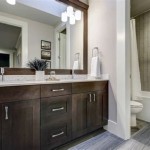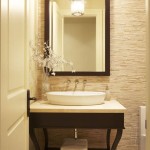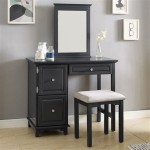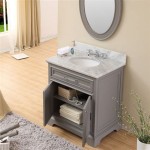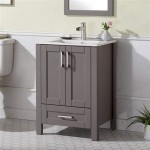Bathroom Vanity Drawer Replacement Parts: A Comprehensive Guide
The bathroom vanity drawer plays a critical role in bathroom organization. Over time, constant use and exposure to moisture can lead to wear and tear, resulting in the need for replacement parts. This article provides a comprehensive overview of common bathroom vanity drawer replacement parts, focusing on identification, selection, and considerations for a successful repair.
Identifying Common Bathroom Vanity Drawer Problems
Before considering replacement parts, a thorough assessment of the drawer's condition is essential. Common problems include drawer slide malfunctions, damaged drawer boxes, broken drawer fronts, and loose or missing hardware. Each problem necessitates a specific approach to identify the required replacement parts.
Drawer Slide Malfunctions: Drawer slides, the mechanisms that allow the drawer to smoothly open and close, are prone to wear. Symptoms include sticking, squeaking, or complete failure to extend or retract. The type of drawer slide – side-mount, undermount, or center-mount – must be identified before ordering replacements. Measuring the length of the slides is crucial for ensuring compatibility.
Damaged Drawer Boxes: The drawer box itself, typically constructed from wood or particleboard, can suffer from water damage, warping, or structural failure. Signs of damage include swollen wood, delamination, or cracks in the material. The dimensions of the drawer box, including height, width, and depth, must be accurately measured to ensure the replacement fits correctly within the vanity cabinet.
Broken Drawer Fronts: The drawer front, the visible face of the drawer, is susceptible to damage from impacts, water exposure, or simply aging. The front may crack, chip, or detach from the drawer box. Replacement fronts must match the existing style and finish of the vanity. Measurements of the existing drawer front are vital for a proper fit.
Loose or Missing Hardware: Drawer pulls, knobs, and mounting screws can loosen, break, or go missing. These smaller components can often be replaced individually. Identifying the style and size of the original hardware is important for maintaining a cohesive look in the bathroom.
Types of Bathroom Vanity Drawer Replacement Parts
Once the problem is identified, the appropriate replacement parts must be selected. A wide range of components are available, each designed to address specific issues.
Drawer Slides: Drawer slides are available in various styles, load capacities, and extension lengths. Side-mount slides are attached to the sides of the drawer box and the cabinet frame. Undermount slides are concealed beneath the drawer box, providing a cleaner aesthetic. Center-mount slides are a single slide positioned in the center of the drawer. Ball-bearing slides offer smoother operation and higher load capacities compared to roller slides. Soft-close slides incorporate a mechanism that gently closes the drawer, preventing slamming.
Drawer Boxes: Replacement drawer boxes are available in pre-assembled or unassembled kits. Pre-assembled boxes are convenient but may require modifications to fit specific vanity dimensions. Unassembled kits allow for custom sizing but require assembly. Common materials include solid wood, plywood, and particleboard with melamine or laminate finishes. Solid wood offers durability and a natural aesthetic, while plywood provides dimensional stability and resistance to warping. Particleboard is a cost-effective option but is more susceptible to water damage unless properly sealed.
Drawer Fronts: Replacement drawer fronts can be sourced from manufacturers specializing in custom cabinet components. They can be constructed from solid wood, MDF (medium-density fiberboard), or particleboard with various finishes, including paint, stain, and laminate. When selecting a replacement drawer front, it's crucial to match the existing style, color, and edge profile of the other vanity components. The bore holes for mounting hardware must also be compatible with the existing drawer box.
Drawer Hardware: Drawer pulls and knobs are available in a wide range of styles, materials, and finishes. Common materials include metal, ceramic, glass, and wood. The size and spacing of the mounting screws must match the existing holes in the drawer front. Consider selecting hardware that complements the overall aesthetic of the bathroom.
Drawer Bottoms: Drawer bottoms, typically constructed of thin plywood or hardboard, can become damaged or warped. Replacement bottoms are available in standard sizes and can be cut to fit specific drawer dimensions. The bottom is typically attached to the drawer box using staples, nails, or glue.
Corner Braces and Supports: Corner braces and drawer supports reinforce the drawer box and prevent sagging. They are typically made of metal or plastic and are attached to the corners of the drawer box using screws. These components are especially useful for drawers that hold heavy items.
Considerations for Selecting Replacement Parts
Several factors must be considered when selecting bathroom vanity drawer replacement parts to ensure a successful repair and long-lasting solution.
Accurate Measurements: Precise measurements are critical for ensuring that the replacement parts fit correctly. Measure the dimensions of the existing drawer box, drawer front, and drawer slides carefully. It is recommended to measure multiple times and record the measurements accurately.
Material Compatibility: When replacing drawer boxes or fronts, consider the material compatibility with the existing vanity. Matching the material helps maintain a consistent appearance and prevents issues with expansion and contraction due to temperature and humidity changes. For example, if the existing vanity is made of solid wood, replacing a drawer front with particleboard might create a noticeable difference in appearance and durability.
Style and Finish Matching: The replacement parts should match the style and finish of the existing vanity components. This ensures a cohesive and aesthetically pleasing appearance. Pay attention to details such as edge profiles, color variations, and hardware finishes. If an exact match cannot be found, consider replacing all drawer fronts to create a uniform look.
Load Capacity: The load capacity of the drawer slides and drawer box should be appropriate for the intended use of the drawer. If the drawer will be used to store heavy items, such as toiletries or linens, select drawer slides and a drawer box constructed from durable materials with a high load capacity. Overloading a drawer can lead to premature failure of the components.
Ease of Installation: Consider the ease of installation when selecting replacement parts. Pre-assembled drawer boxes and drawer slides with pre-drilled mounting holes can simplify the installation process. If you are not comfortable with DIY projects, consider hiring a professional to install the replacement parts.
Water Resistance: Bathrooms are inherently humid environments, so water resistance is a crucial factor to consider. Select drawer boxes and drawer fronts made from materials that are resistant to moisture damage, such as plywood with a waterproof finish or solid wood with a sealant. Avoid using particleboard in areas prone to water exposure unless it is properly sealed.
Budget: Replacement parts are available at various price points. Determine a budget before starting the project and select parts that meet your needs without exceeding your financial limitations. Consider the long-term cost of using less durable, cheaper materials, which may require more frequent replacement.
Source of Parts: Bathroom vanity drawer replacement parts can be sourced from various suppliers, including home improvement stores, online retailers, and cabinet hardware specialists. Consider the reputation and return policies of the supplier before making a purchase. Reading customer reviews can provide insights into the quality and reliability of the products.
Special Considerations for Antique or Custom Vanities: If the vanity is an antique or custom-built, finding exact replacement parts may be challenging. In these cases, consider contacting a professional cabinet maker or antique restoration specialist. They may be able to fabricate custom replacement parts or repair the existing components.
Tools and Materials Required for Installation: Before starting the replacement process, gather the necessary tools and materials. These may include a screwdriver, drill, measuring tape, level, pencil, safety glasses, and wood glue. Having all the necessary tools and materials on hand will streamline the installation process and prevent delays.
Proper Installation Techniques: Proper installation techniques are essential for ensuring that the replacement parts function correctly and last for a long time. Follow the manufacturer's instructions carefully and pay attention to details such as alignment and screw placement. If you are unsure about any aspect of the installation process, consult a professional or refer to online tutorials.
By carefully identifying the problem, selecting the appropriate replacement parts, and following proper installation techniques, it is possible to effectively repair or replace damaged bathroom vanity drawer components, extending the life and functionality of the vanity.

How To Update An Old Vanity With New Drawers Doors And Paint Southern Hospitality

Bathroom Cabinet Doors Replacements For Vanities Nieu

Making Notched Drawers For The Vanity Cabinet Woodworking

Repairing A Water Damaged Bathroom Vanity

Luxury Classico Sintered Stone Countertop Bathroom Vanity Basin Cabinet White Colour Width 36cm 40cm 44cm 50cm

Glacier Bay Everdean 25 In Single Sink White Bath Vanity With Cultured Marble Top Assembled Ev24p2 Wh The Home

How To Cut And Modify Vanity Drawers For Plumbing Easy Diy Steps Abbotts At Home

Bathroom Vanity Storage And Organization Ideas You Need

Most Popular Vanity Outlets Docking Drawer

Repairing A Water Damaged Bathroom Vanity

